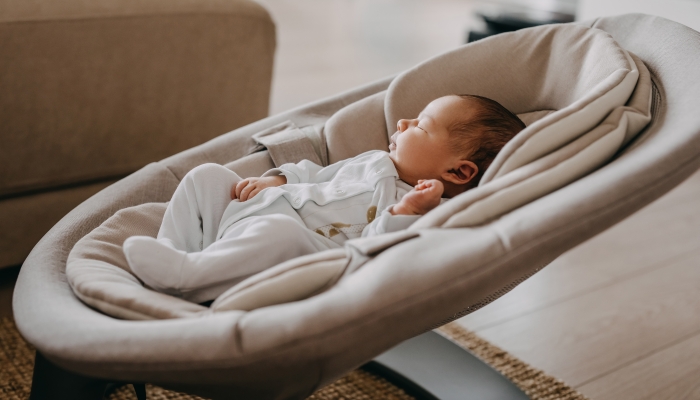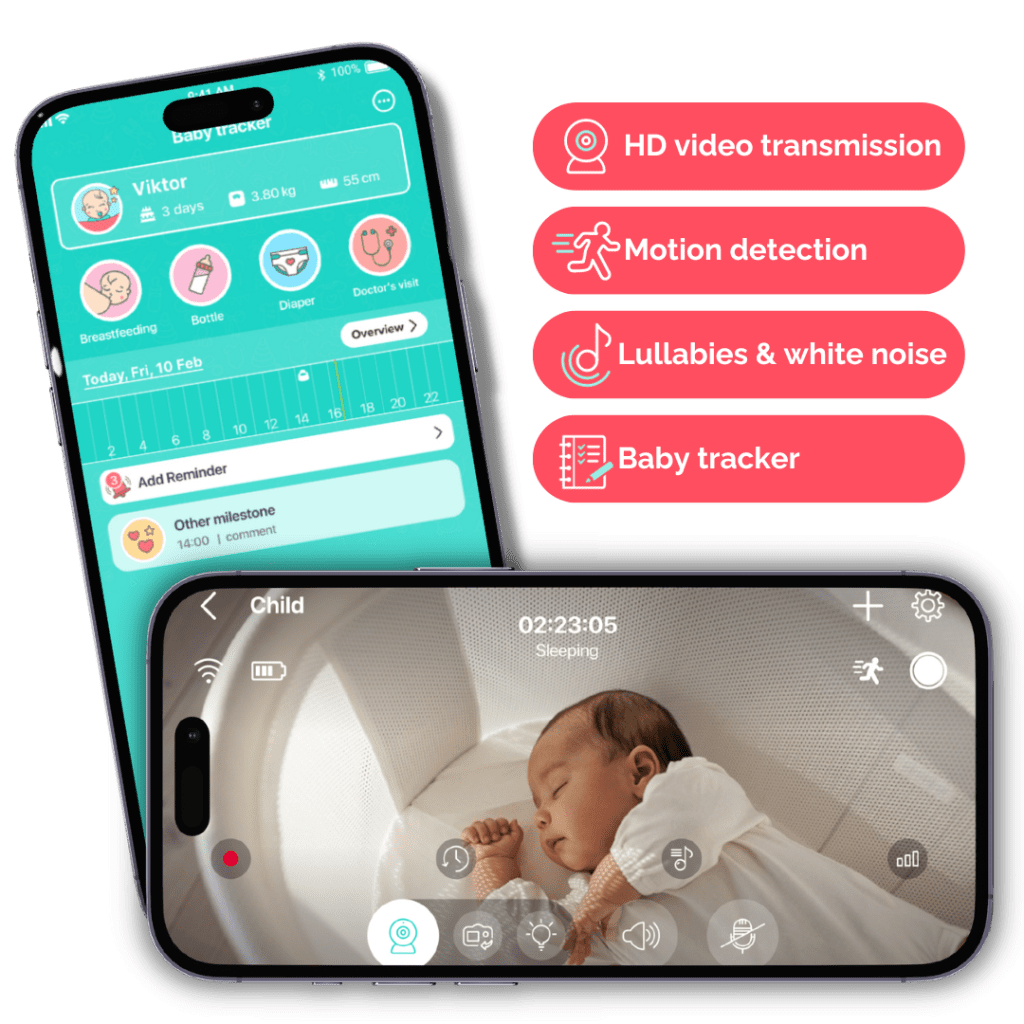
Safe Swinging: How Long Can a Newborn Be in a Swing?
- Created:
11. 10. 2023 - Updated:
8. 11. 2023
For many parents, a sleep swing is the solution to a fussy baby. And this solution proves effective, especially when the parent is frustrated.
But there’s one catch:
Amongst the causes of infant death, baby swings are one of the most common.
You read that right!
So while these swings can be effective pacifiers, just how long can a newborn be in a swing?”
Buckle up and follow along as we explain how to determine the duration your baby should spend in a swing.
How Long Can a Newborn Be In a Swing?
Experts and pediatricians recommend that a newborn spends an hour or less daily in a swing. In addition, the baby shouldn’t spend the whole hour in the swing at a time. Instead, it’s best to split it into at least two sessions of about half an hour or less each.
Here’s where it gets interesting:
Determining how long your newborn spends in a baby swing goes beyond following time limit recommendations.
That’s right.
It requires you to consider their age, physical development, safety, and much more, which we will discuss in this guide.
So hang on. We’re just getting started.
4 Factors Affecting Swing Time
Before we begin:
If you’re using a baby swing or plan to get one for your newborn, you should understand that it’s safe.
However:
Everything comes with a precaution, and baby swings are no exception.
So, while you plan to place your baby in a swing, you should also plan how long they’d spend lying there.
The following are four factors that determine how long your baby should spend in a swing to ensure their safety:
1. The Baby’s Age
This is no shocker:
The younger a baby is, the less time they should spend in a swing.
Hear me out:
While babies can generally spend 30 minutes in a swing, it’s best to reduce this time for your newborn.
And the same goes for young infants within 3-9 months.
Essentially:
Short periods of 15-20 minutes are the ideal duration for your newborn to spend in a swing. This time is sufficient to calm them or help them fall asleep.
However:
Once the baby is up to four months, you can use the swing for about 25-30 minutes per session.
But remember:
Babies shouldn’t spend more than 30 minutes in a swing per time. So, swings aren’t the ideal option for overnight sleep or even naps.
2. Physical Development
Fact:
Newborns are delicate.
This means that external factors can affect their physical development, from their bones to their muscles.
So picture this:
You lay your delicate newborn in a baby swing for them to sleep. And the swing isn’t reclined to the flattest angle.
The first thing you’d notice is that your baby’s posture would follow the angle of the swing. And over time, that position could get uncomfortable for the baby.
Sounds like a bad scenario, doesn’t it?
The truth is:
Using the swing for extended periods may interfere with a newborn’s muscle and skeletal development. And it’s even worse when the swing isn’t reclined to a flat position.
To this effect:
Until your baby can hold their head up (around 4-6 months), it’s best for them to spend as little time as possible in the swing. And you should supervise them and check their posture while they’re in the swing.
3. Health and Safety Risks
It’s a no-brainer:
Before determining how long your baby spends in a swing, you should check if it is safe for your baby.
To do this:
You have to check the swing’s positioning and angle. This gives you an idea of how comfortable or safe it would be for your baby.
Now:
Aside from the risk of Sudden Infant Death Syndrome that comes with using a baby swing extensively, it also poses health risks as well.
For example:
Using the swing for a long period makes the baby assume a certain position for a long period. This position typically includes the back of the baby’s head being pressed into the swing bed.
Now:
A newborn’s head is soft and can adjust shape with the right amount of pressure.
Staying in this lying position for long provides pressure that could cause the baby’s head to assume a flat shape. And that’s never a good sign.
Additionally:
Baby swings aren’t the safest option for calming a fussy baby. They could be shaky, unstable, or inclined at the wrong angle.
4. Behavioral Signs and Symptoms
One of the basic rules of parenting is to pay attention to your baby’s cues.
Factually:
It sounds like such a simple rule, but it goes a long way in helping you keep your baby safe and comfortable.
So:
If your baby shows any signs of discomfort like fussiness, restlessness, or crying, you should remove them from the swing.
That’s not all:
Sometimes, even signs of overstimulation or your baby fighting sleep signal that they need a break from the swing.
In these cases, transferring the baby to a more stable and level platform like the bassinet or a crib is best.

Guidelines And Recommendations For Swing Time
Naturally:
After knowing what could interfere with swing time, it’s only befitting to know how to manage it.
Of course, keeping your newborn in an infant swing for extended periods could put you in a dilemma.
However:
With adequate guidance, you can manage swing time in a way that ensures your baby’s safety and comfort.
So, without further ado:
Here are some guidelines and recommendations for newborn swing time:
1. Time Limits
I totally get it:
It’s not abnormal to forget your baby in a swing, especially if they’re being so calm. I mean, who wouldn’t appreciate some precious time to themselves?
Now, the problem is:
Although it sounds like a dream, your baby being too quiet could signify a problem.
To be on the safe side:
It’s best to set up a system to alert you when the stipulated swing time for your baby runs out. You can do this by setting an alarm or timing the swing session.
As discussed earlier:
Newborns should only spend about 15-20 minutes at a time in a swing. But any duration less than 30 minutes is equally ideal.
So once your baby spends up to 30 minutes, you know it’s time to transfer them to a crib.
In doing so:
You avoid the risk of putting your baby through discomfort, pain, or even developmental issues.
2. Supervision and Interaction
It’s no news:
Babies demand attention. And one of the times they need it the most is during swing time.
Paying attention to your baby while they spend time in the baby swing enables you to pick up their cues. This means that you can notice strange signals like constant crying, restlessness, or sudden movements.
Then again:
Supervising your baby even within the time restrictions doesn’t have to involve just monitoring their behavioral patterns. In fact, while you do so, you can interact with them too.
You can play with your baby or move them into a better position if they don’t look comfortable.
Remember:
While interacting with your baby, don’t overexcite or overstimulate them. This could cause them to be restless and induce stress.
Another way to supervise your infant is by using a baby monitor with both video and audio capacity. This monitor will allow you to see and hear your baby in real-time, so you can know when the infant needs you.
3. Swing Settings
Listen up:
Like other baby equipment, swings have specific settings that are best suited to newborns.
According to the Safe Sleep for Babies Act of 2022, inclined beds or swings are hazardous. Hence, it is vital for a baby to sleep on a flat surface to prevent their head from being higher than their legs. And consequently, reduce the risk of SIDS.
So:
When setting up the swing, you should ensure it reclines to a completely horizontal level. If the swing can’t recline to a flat level, then you shouldn’t use it for your newborn.
It’s also essential to make sure the swing doesn’t tip over or fold easily. To do this, tighten any screws on the swing and make sure it’s sturdy before laying your baby in it.
Furthermore:
Don’t forget to follow the regulations in the swing’s manual when setting it up.
In doing so:
You prevent your baby from tipping over and the swing from folding in with your newborn.
4. Baby Swing Safety Regulations
If I’m being honest:
Aside from setting up your baby swing properly, it’s essential to follow the laid-down safety regulations as well.
For starters:
You must make sure that the swing your baby uses is adequate for their weight.
In addition:
You should never place a baby swing on a raised surface like a table. This action increases the risk of accidents with the swing.
With that in mind:
It’s never a good idea to carry a swing or move it around while your baby is in it. This could cause the swing bars to break, leading to newborn injury.
And injury to your newborn is a situation you don’t want to risk.
To further avoid accidents, ensure to get a swing that has fasteners so you can strap your baby in. Also, make sure play toys are strapped out of the baby’s reach.
Note:
If your baby falls asleep in the swing, immediately transfer them to their crib to get comfortable and safe sleep.
Final Tip: Annie Baby Monitor – A Parent’s Must-Have Product
When it comes to parenting, there’s one product that stands out as a true must-have, and that’s the Annie Baby Monitor.
With its real-time video streaming, audio capabilities, unlimited range, lullabies and white noise player, and baby tracker features, Annie Baby Monitor covers all the bases.
This baby monitor allows you to keep a close watch on your baby and keep track of their sleep, feeding patterns, and even their growth milestones.

Looking for a tool to make parenting easier? Check out the Annie Baby Monitor! It’s the ultimate way to keep an eye on your baby constantly.
Conclusion
Let’s go over it one more time:
Baby swings are safe for newborns as long as you follow the rules.
In most cases, they are effective for calming an infant down and buying parents some free time.
But it comes with a catch:
Keeping a baby in a swing for extended periods could lead to pain, discomfort, and a high risk of SIDS.
As such:
Experts and pediatricians recommend leaving your infant in a swing for no more than 30 minutes at once.
Typically:
The ideal swing duration for newborns is 15-20 minutes daily, but you can determine how long your baby spends in the swing by considering these factors:
- The baby’s age
- Their physical development
- Health and safety risks
- Behavioral signs and symptoms
Analyzing these factors and pairing them with guidelines for selecting swing duration can help you make the right decisions.
With that in mind:
Don’t forget to leave behind a comment if you found this article helpful. You can also leave your suggestions, concerns, and questions, and I’ll get to them as soon as possible.






